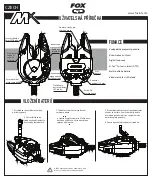
1 . The surface where the machine will be used must be solid and
horizontally level .
2 . The machine is very heavy . Check weight capacity of the table or
counter it is being used on before installing .
3 . These models have 4 adjustable feet . Once you have placed the
machine on the counter, use a level on each side of the belt to ensure
level operation .
4 . Ensure the machine is close enough to a 120V outlet . Contact a
qualified electrician if unsure of your electrical supply .
The potentially most dangerous area of these machines is the two superimposed
cylinders with convergent rotation movements . So, there are safety bars that
obstruct the entry in this area . Those safety bars are completely built in stainless
steel and designed in a way to allow the user to watch the dough .
The machine can only begin its work if the security bars are in working position, that is, completely
down . The machine has an electric protection system that does not allow the machine to work if the
bars are not completely down .
It is forbidden to remove, modify or damage the security bars of the machine .
1 . These models sit on 4 casters with brakes .
2 . Ensure that the installation location is close enough to a 120V outlet .
Contact a qualified electrician if unsure of your electrical supply .
3 . Keep the machine away from potential hazards like fryers, grills, or any
other piece of equipment that can splash hot oil or water onto it .
4 . Unfold the belts down for use and sure enough working clearance . Use a
level on the belts to ensure that the machine is on a level surface .
COUNTERTOP MODELS
FLOOR MODELS
SETUP
NOTE: The manufacturer is not responsible for any damages caused by improper installation.
NOTE: The machine should be ran with a batch of test dough first that will not be used for consumption.
This is necessary to remove any lubricants that are on the rollers/belts from the new machine.
SAFETY FEATURES
3.




































